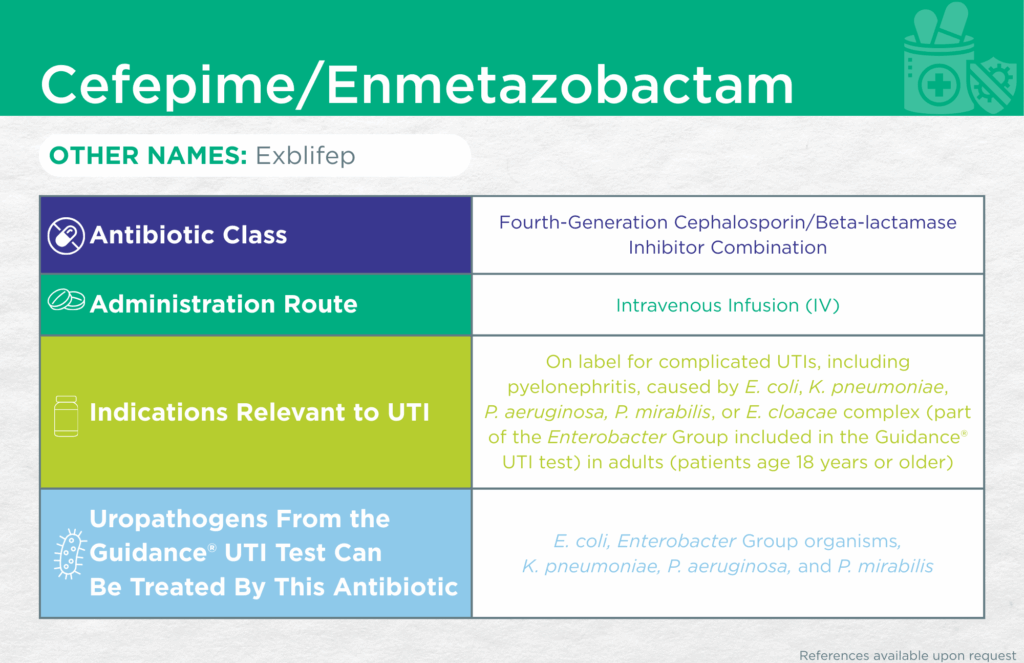Cefepime/Enmetazobactam

Emery Haley, PhD, Scientific Writing Specialist
Cefepime/Enmetazobactam
Find the Latest FDA-Approved Labelling Information Here: Drugs@FDA Online Database
Administrative Routes
Parenteral [intravenous infusion (IV)]
Other Names
Exblifep
Bacteriostatic or Bactericidal
Bactericidal [1]
Antibiotic Class
Fourth-Generation Cephalosporin/Beta-lactamase Inhibitor Combination
Mechanisms of Action
This antibiotic leverages dual mechanisms of action.
Cefepime, a beta-lactam antibiotic, binds to penicillin-binding proteins (PBPs) on bacterial cell walls. PBPs are essential for the formation of peptidoglycan, which gives the bacterial wall strength and integrity. Binding of cefepime to PBPs leads to failure of peptidoglycan cell wall synthesis, causing bacterial cell death.
Some bacteria develop resistance to beta-lactam antibiotics, like cefepime, by producing enzymes, called beta-lactamases, that degrade the antibiotic. Enmetazobactam helps preserve the activity of beta-lactam antibiotics by inhibiting these enzymes and allowing cefepime to then bind to PBPs and cause bacterial cell wall degradation.
WHO AWaRe Classification
Not Listed (FDA approved in 2024 and should be included in WHO AWaRe revision in 2025)
Empiric Use Recommendations
No published guidance; However, IDSA guidelines include this class of combination antibiotic as an alternative therapy for complicated UTI with or without sepsis. [2]
Indication(s) Relevant to UTI
On label for complicated UTIs, including pyelonephritis, caused by Escherichia coli, Klebsiella pneumoniae, Pseudomonas aeruginosa, Proteus mirabilis, or Enterobacter cloacae complex (part of the Enterobacter Group included in the Guidance® UTI test) in adults (patients age 18 years or older).
Checkmarks
CLSI and/or FDA documents support the efficacy of this antibiotic against the following organisms from the Guidance® UTI test: Escherichia coli, Enterobacter Group organisms, Klebsiella pneumoniae, Pseudomonas aeruginosa, and Proteus mirabilis.
- Ishak, A.; Mazonakis, N.; Spernovasilis, N.; Akinosoglou, K.; Tsioutis, C. Bactericidal versus Bacteriostatic Antibacterials: Clinical Significance, Differences and Synergistic Potential in Clinical Practice. J. Antimicrob. Chemother. 2024, 80, 1–17, doi:10.1093/jac/dkae380
- Complicated Urinary Tract Infections (CUTI): Clinical Guidelines for Treatment and Management Available online: https://www.idsociety.org/practice-guideline/complicated-urinary-tract-infections/ (accessed on 28 July 2025).
Dr. Emery Haley is a scientific writing specialist with over ten years of experience in translational cell and molecular biology. As both a former laboratory scientist and an experienced science communicator, Dr. Haley is passionate about making complex research clear, approachable, and relevant. Their work has been published in over 10 papers and focuses on bridging the gap between the lab and real-world patient care to help drive better health outcomes.